PREVIOUS
India Employment Report 2024 - Part 02
November 1 , 2024
347 days
3619
0
India Employment Report 2024 - Part 02
(இதன் தமிழ் வடிவத்திற்கு இங்கே சொடுக்கவும்)
Youth Employment Challenges
- Regional demographic shifts reveal stark disparities in employment outcomes, especially for youth:
- Youth Bulge:
- Many large states in eastern and central India are characterized by a youth bulge but remain relatively underdeveloped with low per capita incomes.
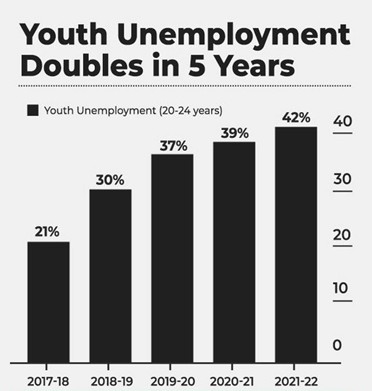
- Education and Employment:
- These regions have few highly educated young people.
- There are not many formal job opportunities.
- Many young people are not working, studying, or getting training.
- Policy Implications:
- There is a pressing need for regional policies aimed at addressing these disparities and promoting balanced opportunities for youth.
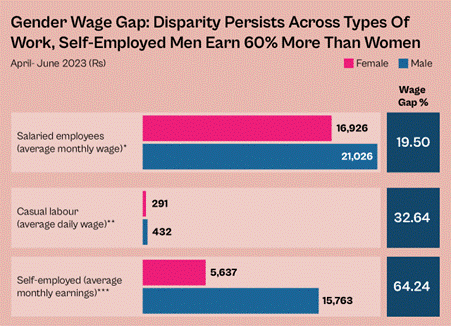
Education and Skills Mismatch
- Employability Crisis
- The proportion of unemployed youths with higher education has risen significantly from 2000 to 2022, highlighting potential mismatches.
- Mismatch Indicators:
- The increase in aspirations among educated youths may indicate a disconnect between educational qualifications and the skills required for high-skill jobs.
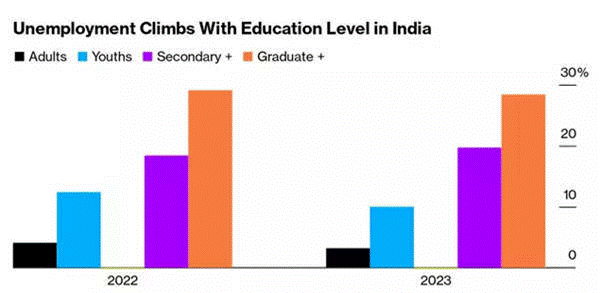
Fast-Changing Technologies and Climate Change
- Emerging Challenges
- Rapid technological advancements pose major challenges for the labor market:
- Artificial Intelligence:
- AI creates both opportunities and challenges for employment, impacting various sectors and job types.
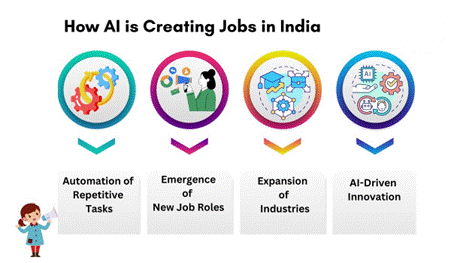
- Climate Change Implications:
- The labor market is increasingly influenced by climate change, which is progressing more rapidly than previously predicted.
- Green Job Opportunities
- While informal sector workers are adversely affected by extreme weather events, new opportunities are emerging.
- Renewable Energy Sector:
- India aims to achieve a transformational target of 500 GW of installed non-fossil fuel electricity generation capacity by 2030.
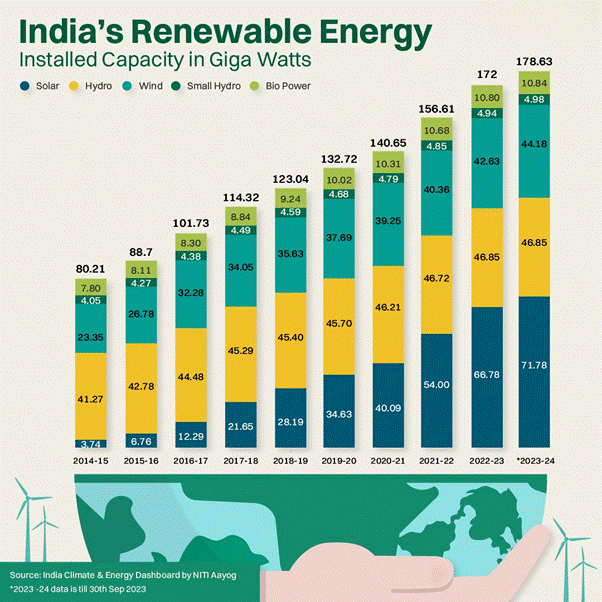
- This shift is expected to create approximately 3.4 million jobs in the solar and wind sectors.
Challenge of Youth Employment
- Demographic Transition
- India is currently at a crucial inflection point in its demographic transition:
- Working-Age Population Growth: The share of the working-age population increased from 59 percent in 2011 to 63 percent in 2021, with expectations of stability over the next 15 years.
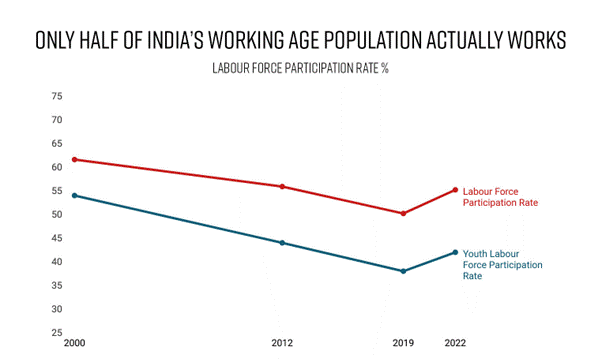
- Demographic Dividend: The country is in the final stage of reaping its demographic dividend.
- Although the proportion of youths in the total population has started to decline, they still represent a significant share (27 percent) and size (371 million persons) compared to many other countries.
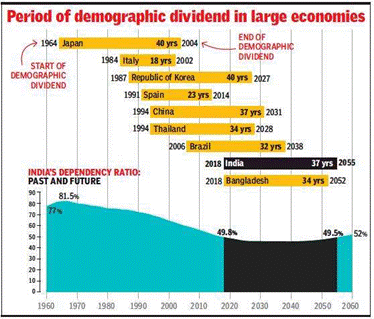
Characteristics of Youth Employment
- Declining Labour Force Participation
- The labor force participation rate (LFPR) among youths has seen a notable decline:
- LFPR Reduction: The LFPR dropped from 54 percent in 2000 to 42 percent in 2022.
- This decline has been particularly sharp among youths aged 15–19, compared to those aged 20–24 and 25–29.
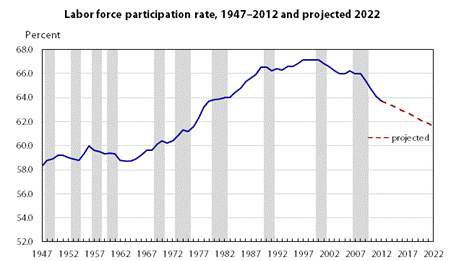
- Worker Population Ratio: The worker population ratio for youths also experienced a downward trend from 2000 to 2019, prior to the COVID-19 pandemic.
- Rising Unemployment
- Reflecting global trends where young people are three times more likely to be unemployed than adults, India's youth unemployment rate is concerning:
- Youth Unemployment Rate: The unemployment rate among youths rose from 5.6 percent in 2000 to 6.2 percent in 2012, then surged nearly threefold to around 18 percent in 2018, and approximately 15.1 percent in 2020.
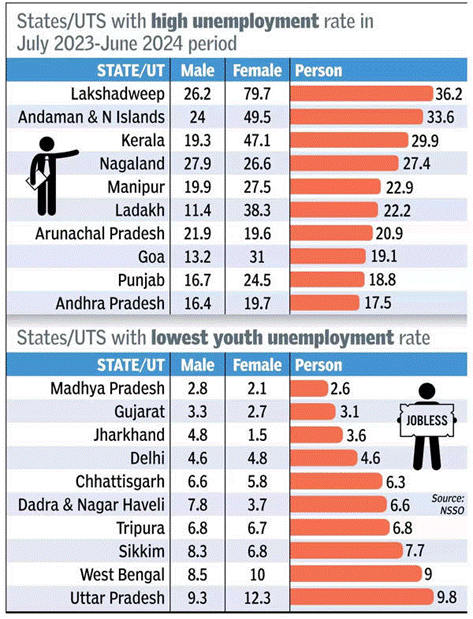
- Educated Youth Unemployment: Unemployment is particularly high among educated youths, with rates exceeding global averages by 2018.
- Implications of Educated Youth Unemployment
- While Indian youths are attaining higher levels of education, the lack of sufficient employment opportunities is evident:
- Declining Participation: The decreasing participation in the labor force and workforce reflects a growing disconnect between education and employment opportunities.
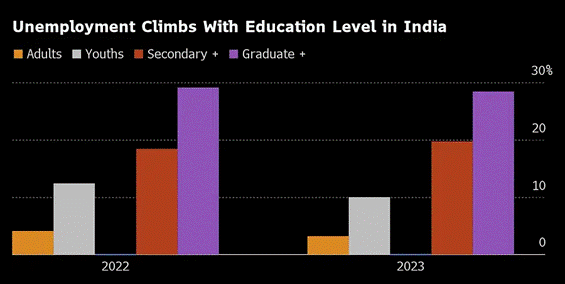
- Societal Implications: The challenge of educated youth unemployment is becoming increasingly significant, with profound implications for societal balance and peace.
- Skills Mismatch and Employment Potential
- Despite the challenges, there are areas within industries where youths can find job opportunities:
- Modern Skills Demand: Certain sectors demand modern skills rather than traditional ones, highlighting the potential for youth employment.
- Low Skills and Employability: However, persistent issues related to low skills and employability remain significant barriers to realizing this potential.
Labour Force, Employment, and Unemployment in India
- Labour Force Participation Rate (LFPR)
- Current Status
- The LFPR for individuals aged 15 years and older was 55.2% in 2022.
- This is lower than the world average of 59.8%.
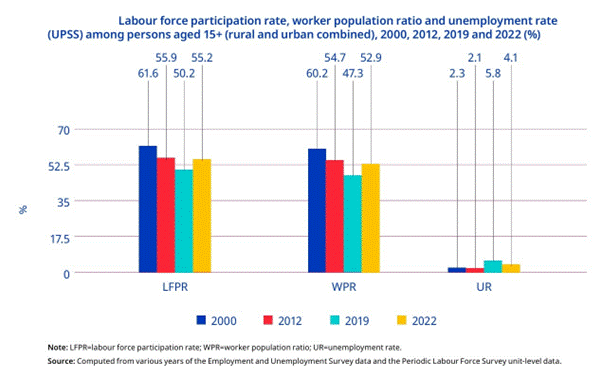
- Historical Trends
- 2000-2019: LFPR declined from 61.6% in 2000 to 50.2% in 2019.
- 2022 Recovery: Increased to 55.2%.
- Worker Population Ratio
- 2000-2019: Decreased from 60.2% in 2000 to 47.3% in 2019.
- 2022 Recovery: Rose to 52.9%.
- Open Unemployment Rate
- 2000: Open unemployment was just over 2%.
- 2012: Remained around 2%.
- 2019: Increased sharply to 5.8%.
- 2022: Significant decrease to 4.1%.
Labour Force and Workforce Growth
- Labour Force Growth
- Increased by 99.2 million, from 396.3 million in 2000 to 495.5 million in 2019.
- Workforce Growth
- Workforce growth was 79.4 million, leading to a rise in open unemployment by 19.8 million.
- 2012-2019 Trends: Open unemployment grew significantly by 18.6 million, with negligible employment generation of only 200,000 persons.
Pandemic Impact (2019-2022)
- Workforce Increase
- Workforce increased by 78 million, from 466.5 million in 2019 to 544.5 million in 2022.
- Labour Force Increase
- Labour force increased by 71.9 million, from 495.5 million in 2019 to 567.4 million in 2022.
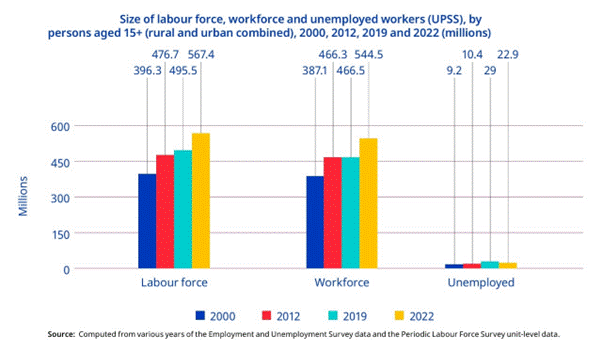
- Unemployment Reduction
- Resulted in a substantial reduction in unemployment by 6.1 million during this period.
Open Unemployment Rate Trends
- Increase in Unemployment (2012-2019)
- Primary Cause: The substantial increase in the open unemployment rate during this period was mainly due to the growth of the labor force.
- This growth occurred without a corresponding increase in employment.
- Impact: This mismatch led to rising unemployment levels, reflecting a significant challenge in job creation.
- Changes from 2019 to 2022
- Labour Force Growth: The increase in the labour force from 2019 to 2022 was accompanied by significant growth in the workforce.
- Unemployment Reduction: This period saw a decrease in unemployment, indicating a more favorable dynamic in the labour market compared to the previous years.
- Quality of Employment Concerns
- ILO Insights (2023): The quality of employment generated during the ongoing global slowdown raises concerns.
- Many workers are compelled to accept low-quality jobs, often with low wages or earnings.
- Implications: This trend highlights the need for better job quality and sustainable employment opportunities to ensure economic stability and worker welfare.
Gender Distribution in Labour Force Participation Rate (LFPR)
- Trends from 2000 to 2019
- Decline in LFPR
- The female LFPR declined sharply by 14.4 percentage points.
- In comparison, the male LFPR decreased by 8.1 percentage points.
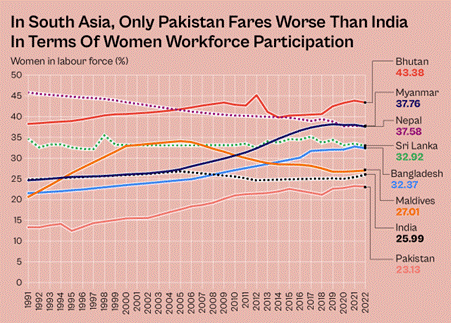
- Changes from 2019 to 2022
- Reversal of Trends
- The trend reversed, with a significant increase in the female LFPR by 8.3 percentage points.
- The male LFPR saw a smaller increase of 1.7 percentage points.
- Trends in Female Labor Force Participation
- This rise in female labor force participation rate (LFPR), along with other labor market changes, indicates that more women are entering the workforce in response to crises.
- This trend is similar to what was observed in 2005.
- Gender Gap in the Labour Market
- Current LFPR Comparison (2022)
- Women's LFPR stood at 32.8%, approximately 2.3 times lower than the male LFPR of 77.2%.
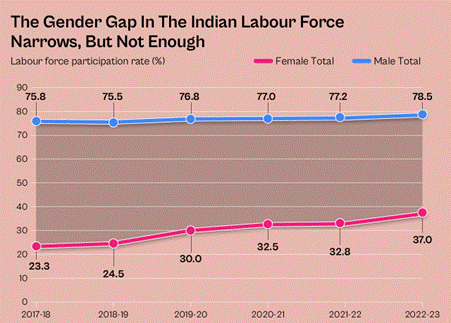
Global Context
- India's low overall LFPR is significantly impacted by the low female LFPR, which is much lower than the world average of 47.3% for 2022.
- However, India's female LFPR is higher than the South Asian average of 24.8%.
Labour Force Participation Rate (LFPR) by Area
- Trends from 2000 to 2019
- Decline in LFPR
- Rural areas experienced a significant decline of 14.1 percentage points.
- Urban areas saw a smaller decline of 3.5 percentage points.
- Changes from 2019 to 2022
- Reversal of Trends
- The LFPR increased by 6 percentage points in rural areas.
- Urban areas had a smaller increase of 2.1 percentage points.
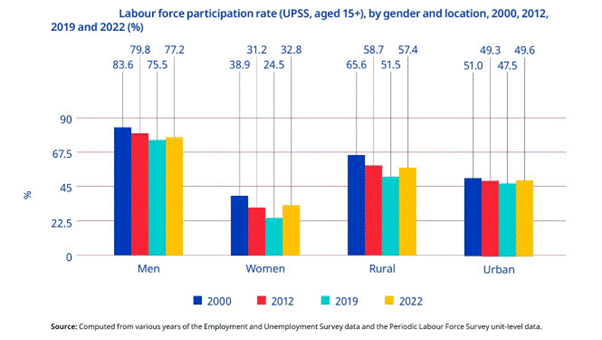
Gender Disparities
- The increase in LFPR was more pronounced among women in rural areas compared to their urban counterparts.
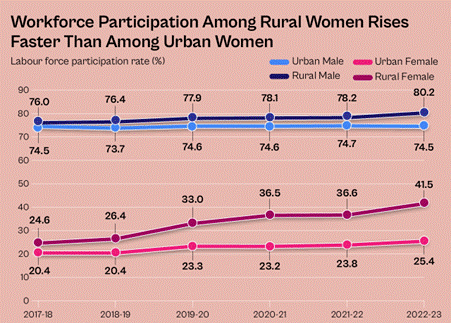
- Worker Population Ratio and Unemployment Trends
- Similar Patterns
- Trends in the worker population ratio mirrored those of the LFPR, leading to a rise in unemployment during the first period and a decline in the more recent period for both men and women in rural and urban areas.
- Unemployment Rate Comparison
- The unemployment rate remained relatively higher in urban areas compared to rural areas.
Trends in Women's Labour Market Participation
- Fluctuations in Participation
- Significant Contributions
- Women’s participation in the labour market, particularly in rural areas, has been a key factor influencing overall LFPR changes over the past two decades.
- Changes in Employment Status
- Subsidiary Employment Trends
- Women's participation in subsidiary employment declined from 8.3% in 2000 to 2.8% in 2019.
- However, this figure increased significantly to 6.3% in 2022.
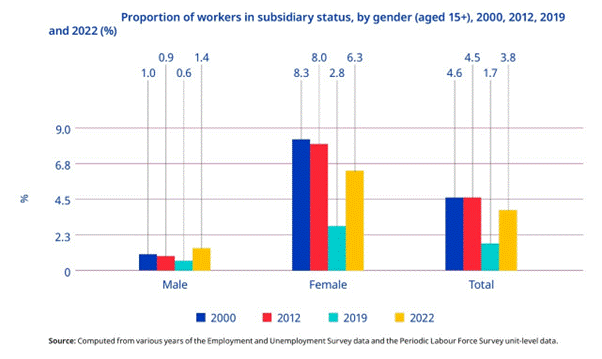
- Implications
- This increase shows that women who were previously less attached to the workforce became more active participants in 2022.
- It reflects a shift in their engagement with employment opportunities.
-------------------------------------
Leave a Reply
Your Comment is awaiting moderation.


